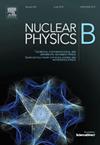Quantum motion of scalar particle under rainbow gravity effects in spherical symmetrical Gödel-type metric with a topological defect
IF 2.5
3区 物理与天体物理
Q2 PHYSICS, PARTICLES & FIELDS
引用次数: 0
Abstract
In this research contribution, we explore the relativistic quantum dynamics of spin-0 scalar particles within a curved space-time background containing topological defects, while incorporating the effects of rainbow gravity. The Klein–Gordon equation is solved in a spherically symmetrical Gödel-type space-time, considering the presence of topological defects and the influence of rainbow gravity, described by the line-element: The functions and , where , E is the particle's energy, and the Planck's energy, are referred to as rainbow functions. Analytical solutions for the energy levels and wave-functions of scalar particles are obtained through general hypergeometric equations for the pair of rainbow functions: (i) and , and (ii) and . Notably, we demonstrate that the energy levels and wave-functions of scalar particles are intricately linked to the topological defect of cosmic string, characterized by the parameter α, and the constant angular speed of the rotating frame, characterized by the parameter Ω. Furthermore, the influence of the rainbow parameters is evident in the eigenvalue solutions, introducing modifications compared to known expressions. It is worth mentioning that the presence of topological defects breaks the degeneracy of the energy levels, resulting in substantial modifications. These findings underscore the interplay between rainbow gravity, topological defects, and the intrinsic properties of scalar particles within a curved space-time framework.
具有拓扑缺陷的球形对称Gödel-type度规中彩虹引力效应下标量粒子的量子运动
在本研究中,我们探索了包含拓扑缺陷的弯曲时空背景中自旋为0的标量粒子的相对论量子动力学,同时考虑了彩虹引力的影响。考虑到拓扑缺陷的存在和彩虹引力的影响,在球对称Gödel-type时空中求解Klein-Gordon方程,其描述为线元:ds2=−{dtF+αΩr2(1+r24R2)−1dφG}2+G−2{(1+r24R2)−2(dr2+α2r2dφ2)+dz2}。函数F=F(χ)和G=G(χ),其中0<;χ(=|E|Ep)≤1,E为粒子能量,Ep为普朗克能量,称为彩虹函数。利用彩虹函数对(i) F(χ)=1和G(χ)=(1+κχ)和(ii) F(χ)=(e - β0χ - 1)β0χ和G(χ)=1的一般超几何方程,得到标量粒子能级和波函数的解析解。值得注意的是,我们证明了标量粒子的能级和波函数与宇宙弦的拓扑缺陷(以参数α为特征)和旋转框架的恒定角速度(以参数Ω为特征)有着复杂的联系。此外,彩虹参数(κ,β0)的影响在特征值解中是明显的,与已知表达式相比,引入了修改。值得一提的是,拓扑缺陷的存在打破了能级的简并,导致了实质性的修正。这些发现强调了彩虹引力、拓扑缺陷和弯曲时空框架内标量粒子的内在特性之间的相互作用。
本文章由计算机程序翻译,如有差异,请以英文原文为准。
求助全文
约1分钟内获得全文
求助全文
来源期刊

Nuclear Physics B
物理-物理:粒子与场物理
CiteScore
5.50
自引率
7.10%
发文量
302
审稿时长
1 months
期刊介绍:
Nuclear Physics B focuses on the domain of high energy physics, quantum field theory, statistical systems, and mathematical physics, and includes four main sections: high energy physics - phenomenology, high energy physics - theory, high energy physics - experiment, and quantum field theory, statistical systems, and mathematical physics. The emphasis is on original research papers (Frontiers Articles or Full Length Articles), but Review Articles are also welcome.
 求助内容:
求助内容: 应助结果提醒方式:
应助结果提醒方式:


